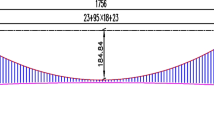Abstract
Aerodynamic damping is a key factor that influences the wind-induced responses of transmission conductors. The inaccurate estimation of aerodynamic damping leads to misunderstanding of conductor response to wind actions. For dynamic response analysis in the frequency domain, the generalized aerodynamic damping matrix used to solve conductor motion is diagonal. This study reanalyzed the conductor generalized aerodynamic damping matrix by considering its horizontal and vertical motions and the coupling effects of different modes. The derived generalized aerodynamic damping was a nondiagonal matrix, and we defined it as nonproportional generalized aerodynamic damping. Variations in the aerodynamic damping ratio and the nonproportionality of generalized aerodynamic damping with wind speed were investigated through numerical studies of single- and triple-span conductors. Triple-span conductors with different span lengths, hanging heights, and initial pretension forces were adopted to discuss the effects of the nonproportionality of generalized aerodynamic damping on estimating the dynamic responses of conductors. Results showed that neglecting the vertical motion of a conductor leads to an overestimation of the aerodynamic damping ratio, especially under high wind speed conditions. The nonproportionality of generalized aerodynamic damping is highest when the incoming wind speed at 10 m is 25 m/s. Ignoring such nonproportionality leads to an overestimation of the resonant responses of conductors but exerts minimal effects on total fluctuating responses mainly contributed by background components. Therefore, for a transmission conductor with a significant resonant response, the nonproportionality effect of generalized aerodynamic damping must be considered. Increasing span length and conductor height or reducing initial pretension force seems to enhance nonproportionality effects on conductor responses.
Similar content being viewed by others
References
T. Li, B. Luo, L. Liu and T. Wu, Wind accident analysis of transmission line in China southern power grid’s coastal regions, 2015 5th International Conference on Electric Utility Deregulation and Restructuring and Power Technologies (DRPT), Changsha, China (2015) 1700–1704.
B. Yan, X. Lin, W. Luo, Z. Chen and Z. Liu, Numerical study on dynamic swing of suspension insulator string in overhead transmission line under wind load, IEEE Transactions on Power Delivery, 25 (1) (2010) 248–259.
H. Aboshosha and A. E. Damatty, Dynamic response of transmission line conductors under downburst and synoptic winds, Wind & Structures, 21 (2) (2015) 241–272.
A. M. Loredo-Souza and A. G. Davenport, The effects of high winds on transmission line, Journal of Wind Engineering & Industrial Aerodynamics, 74–76(98) (1998) 987–994.
A. Hamada and A. A. El Damatty, Behaviour of guyed transmission line structures under tornado wind loading, Computer and Structures, 89 (11–12) (2011) 986–1003.
A. G. Davenport, Gust response factors for transmission line loading, Proceedings of the Fifth International Conference, Fort Collins, Colorado, USA (1979) 899–909.
Y. Momomura, H. Marukawa, T. Okamura, E. Hongo and T. Ohkuma, Full-scale measurements of wind-induced vibration of a transmission line system in a mountainous area, Journal of Wind Engineering & Industrial Aerodynamics, 72 (1) (1997) 241–252.
J. D. Holmes, Wind Loading of Structures, CRC Press, New York, USA (2003).
M. J. Matheson and J. D. Holmes, Simulation of the dynamic response of transmission lines in strong winds, Eng. Struct., 3 (2) (1981) 105–110.
D. Stengel, K. Thiele, M. Clobes and M. Mehdianpour, Aerodynamic damping of nonlinear movement of conductor cables in wind tunnel tests, numerical simulations and full scale measurements, Journal of Wind Engineering & Industrial Aerodynamics, 169 (2017) 47–53.
D. Wang, X. Chen and J. Li, Prediction of wind-induced buffeting response of overhead conductor: Comparison of linear and nonlinear analysis approaches, Journal of Wind Engineering & Industrial Aerodynamics, 167 (2017) 23–40.
V. Gattulli, L. Martinelli, F. Perotti and F. Vestroni, Dynamics of suspended cablesunder turbulence loading: Reduced models of wind field and mechanical system, J. Wind Eng. Ind. Aerodyn., 95 (3) (2007) 183–207.
S. Haddadin, H. Aboshosha, A. E. Ansary and A. E. Damatty, Sensitivity of Wind Induced Dynamic Response of a Transmission Line to Variations in Wind Speed, Canadian Society of Civil Engineers, London, Canada (2016) 534.
M. Tong, Z. Liang and G. C. Lee, An index of damping non-proportionality for discrete vibrating systems, Journal of Sound & Vibration, 174 (1) (1994) 37–55.
GB 50009–2012. Load Code for the Design of Building Structures, China Building Industry Press, Beijing, China (2011).
A. G. Davenport, The Relationship of wind structure to wind loading, Proc. of the Symposium on Wind Effect on Building and Structures, London, Canada, 1 (1966).
Acknowledgments
This work is supported by the National Natural Science Foundation of China (Nos. 51508502, 51378468, 51678525 and 51838012) and Zhejiang Provincial Natural Science Foundation of China (No. LY19E080026). This support is greatly acknowledged.
Author information
Authors and Affiliations
Corresponding author
Additional information
Recommended by Associate Editor Gyuhae Park
Haiwei Xu is a lecturer at the College of Civil Engineering and Architecture, Zhejiang University, Hangzhou, China. He received his Ph.D. degree in civil engineering from Zhejiang University. His research interests include structural dynamic analysis, risk assessment, and wind engineering and aerodynamics.
Rights and permissions
About this article
Cite this article
Lou, W., Wu, D. & Xu, H. Wind-induced conductor response considering the nonproportionality of generalized aerodynamic damping. J Mech Sci Technol 33, 3075–3084 (2019). https://doi.org/10.1007/s12206-019-0602-9
Received:
Revised:
Accepted:
Published:
Issue Date:
DOI: https://doi.org/10.1007/s12206-019-0602-9




